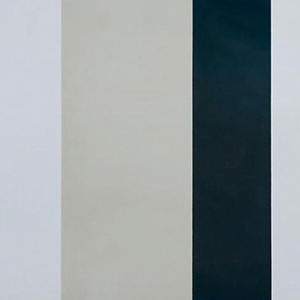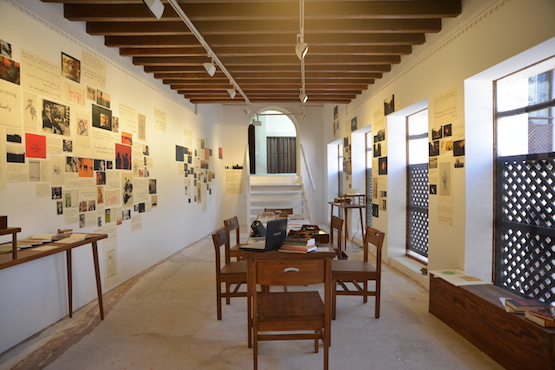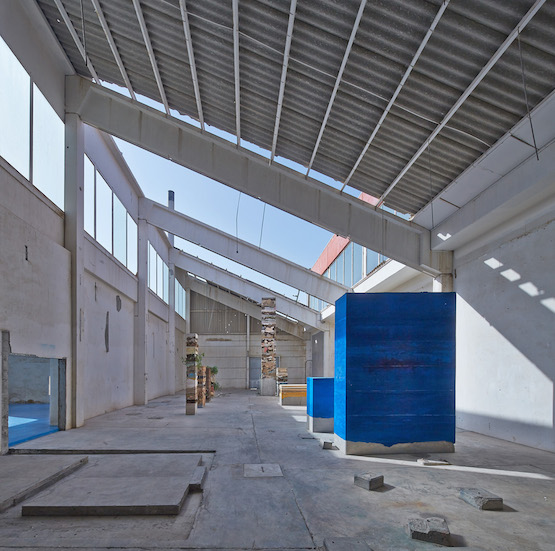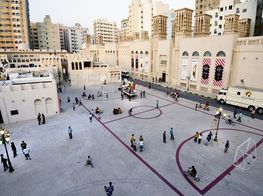Great Expectations: Sharjah Biennial 12
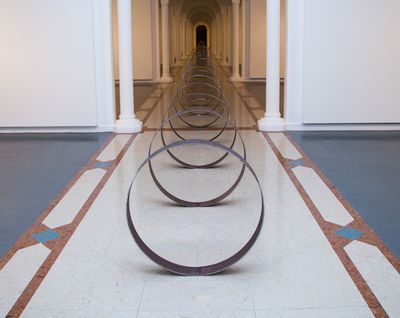
It’s amazing how expectations of art differ according to context. Consider one New Yorker writer’s disappointment for not seeing enough “political art” at this year’s Art Basel in Hong Kong, no doubt an expectation driven by the city’s Umbrella Movement. Or the conclusion by an artnet critic that the current Sharjah Biennial 12, The past, the present, the possible, (curated by Eungie Joo with associate curator Ryan Inouye)—which presents fifty-one artists from some twenty-five countries—plays it too safe by avoiding the UAE’s hot issues: labor, human rights, religion. You have to feel sorry for artists, sometimes, not to mention the institutions that support them, especially when art is expected to represent politics in a way that reduces its complexity. After all, there is political art at Sharjah Biennial 12 (SB12): but nuance trumps dogmatism.
Asunción Molinos Gordo, WAM (World Agriculture Museum), 2010/2015. Mixed-media installation. Dimensions variable. Courtesy of the artist. Exhibition view, Sharjah Biennial 12. Image courtesy of Sharjah Art Foundation. Photo by Alfredo RubioConsider Asunción Molinos Gordo's playful World Agriculture Museum (WAM) (2010/2015): a parody of the Agricultural Museum in Cairo complete with hand painted displays and vitrines, presented in an empty warehouse at Port Khalid. The installation considers power relations within hegemonic agricultural industries, and charts a kind of history of food crises. In one room, the signs for various “departments” hang high on the walls bar one, which is left on the floor: “labour.” The gesture is subtle enough, though not as subtle (or admittedly, as elegant) as Cinthia Marcelle’s AT THE RISK OF THE REAL (2015): a courtyard outfitted with a ceiling of sieves through which sand is periodically released by paid workers. Marcelle took inspiration from the abandoned fishing village Al Khan, where sand has been excavated for construction projects—a reference to the rampant and increasingly deadly and global trade in sand for building, at the cost not only of environments and migrant workers, but also communities.
Cinthia Marcelle, AT THE RISK OF THE REAL, 2015. Wooden beams, sieves, sand, tools and regular activation. 22.5 x 17.7 x 3.2 m. Commissioned by Sharjah Art Foundation. Courtesy Galeria Vermelho, São Paulo, and the artist. Exhibition view, Sharjah Biennial 12. Image courtesy of Sharjah Art Foundation. Photo by Alfredo Rubio.AT THE RISK OF THE REAL is expansive: a geopolitical mapping in which locality is linked to a global mainframe through which resources, from material to human, are traded. This is expanded historically in Rayanne Tabet’s installation Steel Rings (2013–) which references the Trans-Arabian Pipeline Company, established in 1946 to build a pipeline that linked Saudi Arabia and Lebanon via Jordan, Syria, and after 1967, the Golan Heights, until 1983, when the line was abandoned and the company dissolved.
Material histories are interrogated further in concise showcases of work by Etel Adnan, Saloua Raouda Choucair, Lala Rukh, and Abdul Hay Mosallam Zarara, whose activist art in support of the Palestinian liberation movement is on full display. Highlights include paintings and sculptural studies by 20th Century avant-garde femme Fahrelnissa Zeid, and Jac Leirner’s investigations into time, through which politics seep out once more. Take Leirner’s Os cem (roda) [The one hundreds (wheel)] (1985–1986): a circle made out of hundred cruzeiro notes made worthless during the devastating devaluation and collapse of Brazil’s currency.
Jac Leirner, Os cem (roda) [The one hundreds (wheel)], 1985–1986. Image courtesy of Sharjah Art Foundation. Photo by Alfredo RubioIn thinking about the global relations at play within the context of Sharjah and the region, two other works draw fascinating links between the Gulf and Korea. Im Heung-Soon’s two-channel video installation Reincarnation (2015), studies a community of Korean women who moved to Iran after working the foxhole circuit, which provided entertainment for the Korean troops during the Vietnam War. Haegue Yang’s An Opaque Wind (2015) presents a courtyard garden installation that references the economic relations between Korea and the Gulf since the 1970s. The complexity that arises out of such stories is abstracted fully through Byron Kim’s Sky Blue Flag (2015), which was raised on Sharjah’s Corniche. The work seems to propose a wipe out of nationalism altogether in favour of a universal heritage—one world under one sky. It is a proposal of sorts for an intertextual social fabric: a monochrome for the 21st century. (Quite the statement in a nation plagued by migration and citizenship concerns.)
Haegue Yang, An Opaque Wind, 2015. Mixed-media installation. Commissioned by Sharjah Art Foundation. Courtesy Galerie Chantal Crousel, Paris; Greene Naftali, New York; Kukje Gallery, Seoul; Galerie Wien Lukatsch, Berlin; and the artist. Exhibition view, Sharjah Biennial 12. Image courtesy of Sharjah Art Foundation. Photo by Deema Shahin. Kim’s political abstraction finds grounding in Xu Tan’s Social Botany Project (2012), which engages with the meaning of keywords through interviews with residents displaced by development projects around China’s Pearl River Delta. In one video, the artist considers freedom and how such a notion might operate today: a question that is crucial in a world where democracy appears to be as much a failed experiment as communism. Perhaps this is why a key theme to emerge out of the works assembled at the Sharjah Art Museum—a main venue for the Biennale and where Tan’s work is on show—is transcendence through matter. These converged in Hassan Sharif’s Wooden Column (1985): a form commonly used to block parking spaces in the Sharjah souk encased in a vitrine and surrounded by drawings and plans that imagine the object’s release from a confined—and fixed—state.
In many ways, this sense of release was also bestowed on SB12’s participating artists, too. The majority were invited to produce new and site-specific commissions without being given an assigned theme aside from the context of Sharjah, and the question of the possible. At the heart of this approach was an insistence on place and presence, not to mention the facilitation of interactions amongst participants. In the lead up to the opening visits were made, discussions were had, ideas were considered, and friendships were formed. In Byron Kim's Sunday Paintings, an ongoing series of square paintings of the sky over which Kim enters short diary entries, Kim even mentions dining with participating artists Basel Abbas and Ruanne Abou-Rahme in New York.
Byron Kim, works from the series Sunday Paintings, 2001. Acrylic and ink on canvas, mounted on panel 36 x 36 cm each. Courtesy James Cohan Gallery, New York, and the artist. Exhibition view, Sharjah Biennial 12. Image courtesy of Sharjah Art Foundation. Photo by Alfredo Rubio.The result of such a flexible curatorial frame has been the production of ambitious new works that expand on practices that have been investigating questions surrounding the experience of the present through object and image. Take Lee Kit’s concise and more pessimistic installation, Is it always there?, in which the essence of abstract painting is explored through a series of precisely considered interventions in space, from the projection of a video, to light on walls that have been added to, covered, or marked. The feeling Kit invokes—the spectre of the room—is “the darkness”: “a mysterious entity” that is “omnipresent” but “necessarily ignored." In the case of Iman Issa, Heritage Studies #1-5, a new series that makes abstract sculptural references to existing museum objects, art works and other historical mementos, became an extension of a practice that has been solidly investigating the notion of common memories for years.
Of these new commissions, the four-channel video installation When the fall of the dictionary leaves all words lying in the streets (2015), by Basel Abbas and Ruanne Abou-Rahme, deservedly won the 2015 Sharjah Biennial Prize. This is the third and final installment of The Incidental Insurgents, a project started in 2012 that explores, as Kevin Jones explained, “the liminal space between the political present and its unseen potential direction." The study is a fierce and rigorous interrogation of a crisis in politics: a search for alternatives that have so often felt elusive. Told through the structure of an archive and a narrative of what ultimately constitutes a road movie, The Incidental Insurgents is intimately linked to SB12’s aims: to locate the politics of art precisely in the imagination’s ability to consider what is possible as real. Take the protagonists in the films, who are always filmed from behind, constantly moving through the battered landscape of the West Bank in forward motion. The work's abstraction—the revolutionary road and the revolutionary—is located in historical terms: from Victor Serge in Paris, two members of a bandit gang in 1930s Palestine, Abu Jilda and Arameet, and 1970s Mexico courtesy of Roberto Bolano's The Savage Detectives, which locates the artist in this project as the ultimate bandit (read: insurgent). As Katya García-Antón wrote for frieze, in Bolano's novel, the "author firmly eschews ivory towers and plants the writer within ‘the territory of risk (of life)’." Linking history from then to now, The Incidental Insurgents locates the possible as something beyond reach, but tangible. Struggle is a historical journey of which the present is but one part.
Basel Abbas and Ruanne Abou-Rahme, The Incidental Insurgents (Parts 1–3), 2012–15. Mixed-media installation, Partial commission by Sharjah Art Foundation. Courtesy Carroll/Fletcher, London, and the artists. Exhibition view, Sharjah Biennial 12. Image courtesy of Sharjah Art Foundation. Photo by Alfredo Rubio.Thus, from the movement of bodies within works, including Ahmad Ghoussein's mapping of South Lebanon through a magician the artist assisted throughout his childhood in The Fourth Stage (2015), this biennial also considered the movement of bodies within space. This was articulated through the inclusion of new sites beyond the Heart of Sharjah and its immediate vicinity as biennial sites for the first time: the warehouse at Port Khalid on the other side of Sharjah’s Corniche, to the Flying Saucer, a 1970s-era chicken restaurant, and the abandoned ice factory in Kalba on Sharjah’s eastern coast. The latter location is where Adrián Villar Rojas’s ambitious site-specific Planetarium is installed: a series of magnificent totems that appear like stratigraphic sections taken from a square core drill, with objects from trainers, plants, shells to dead birds collected all over the UAE squashed between the layers.
In many ways a counter-balance to Marcelle’s and Gordo's criticism of the infrastructure of development and consumption, Villar Rojas completed Planetarium’s composition with piles of compost organised in columns that lead up to the ice factory entrance, a reference to the filtration system the artist saw at Sharjah’s compost plant, which has been in operation since 1978. The homage is somewhat positive: the plant produces the natural fertiliser and soil conditioner that sustains the UAE's greenery. It is a demonstration of how, as Villar Rojas notes, “increased consumption and demographic expansion can be transformed into living parts of the environment.”
Adrián Villar Rojas, Planetarium, 2015. Site-specific installation. Commissioned by Sharjah Art Foundation. Courtesy kurimanzutto, Mexico City; Marian Goodman Gallery, New York; and the artist. Exhibition view, Sharjah Biennial 12. Photo: Jörg Baumann. © 2015 baumann fotografie frankfurt a.m.Of course, one could dismiss Planetarium as avoidant of real issues—including the environmental concerns surrounding water consumption and waste in the UAE. Yet, this dismissal would be unfair, given the work not only articulates a ground-up view of development as an organic and historical process: a perspective that is also articulated in the Sharjah Biennial’s steady evolution. It also points to a much larger, global issue—the recent droughts in California being a case in point—and considers what is being done in response.
In this sense, it is interesting that SB12 has made many appreciate Yuko Hasegawa's SB11, Re:Emerge—Towards a New Cartography, more, even if this edition was also critiqued for playing things too safe when it opened in 2013. In many ways, SB11 was a tonic to the heat of *that* biennial in 2011, when Mustapha Benfodil’s installation, It Has No Importance, was removed on the grounds that is was not suitable for the public space it was situated—next to a local mosque, where children play. SB11 was a reset after the furore, within which the Sharjah Biennial took stock of its responsibilities towards its local audience, and its priorities as a cultural and political platform.
Sharjah Biennial 12 feels like a continuation of this measured focus: a consideration of how a biennial exhibition might operate as an agent for sustained growth by encouraging and enabling complex interactions. These do not always have to be hostile either. Consider Rirkrit Tiravanija’s Untitled (Eau de Rose of Damascus) (2015), a communal garden with a rosewater distillery and kitchen where biennial visitors may rest, and reflect. Today, when there is so much at stake, it takes real space and time to consider the possible. SB12 granted as much as it could.—[O]
Rirkrit Tiravanija, untitled 2015 (Eau de Rose of Damascus). Mixed-media installation. Commissioned by Sharjah Art Foundation. Courtesy of the artist. Exhibition view, Sharjah Biennial 12. Image courtesy of Sharjah Art Foundation. Photo by Shanavas Jamaluddin.
Sharjah Biennial 12: The Past, the present, the possible
5 March – 5 June, 2015
Sharjah, United Arab Emirates

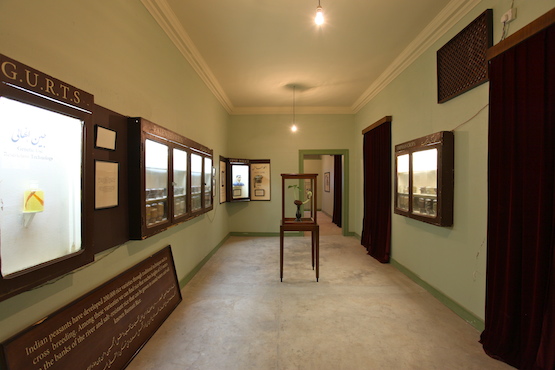

![Jac Leirner, Os cem (roda) [The one hundreds (wheel)], 1985–1986. Image](https://files.ocula.com/anzax/bd/bd29d874-81e2-482d-beff-96b3b01e59a0.jpg)

